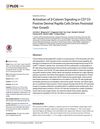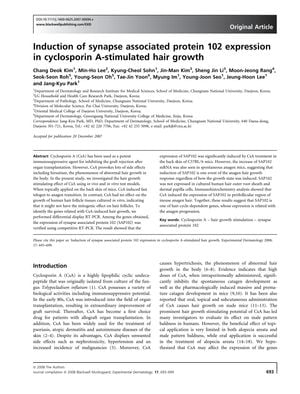TLDR Cyclosporin A promotes hair growth in mice and increases a protein linked to hair growth, but it may not work the same way in humans.
In the 2008 study, researchers found that Cyclosporin A (CsA) applied topically to mice induced a transition from the resting phase to the growth phase of hair follicles, suggesting a positive effect on hair growth. However, CsA did not stimulate growth in cultured human hair follicle tissues, indicating that its effects might not directly translate to human hair growth. The study also discovered an increase in synapse associated protein 102 (SAP102) expression in the skin of CsA-treated mice, which was also present during the natural growth phase of hair, suggesting that SAP102 is associated with hair growth. SAP102 was not expressed in cultured human hair cells, and its expression was localized to the perifollicular region of mouse hair, implying that its role in hair growth is not direct and requires further investigation.
45 citations
,
September 2001 in “Journal of Investigative Dermatology” Cyclosporin A promotes hair cell growth and affects protein kinase C levels.
112 citations
,
February 2001 in “Journal of Investigative Dermatology” Neuropeptides affect hair growth, with some speeding it up and others slowing it down.
 101 citations
,
January 1997 in “Journal of Investigative Dermatology Symposium Proceedings”
101 citations
,
January 1997 in “Journal of Investigative Dermatology Symposium Proceedings” Nerves and chemicals in the body can affect hair growth and loss.
25 citations
,
December 1991 in “The Journal of Dermatology” Cyclosporin A promotes hair growth in young nude mice.
385 citations
,
November 1990 in “Journal of Cell Science” Human hair follicles can grow in a lab setting.
33 citations
,
February 1990 in “Journal of the American Academy of Dermatology” Topical cyclosporine led to significant hair growth in some men with male pattern baldness.
69 citations
,
February 1987 in “Archives of Dermatology” Topical cyclosporine lotion led to hair regrowth in a man with alopecia universalis.
 26 citations
,
July 2016 in “PLOS ONE”
26 citations
,
July 2016 in “PLOS ONE” Activating β-catenin in certain skin cells speeds up hair growth in mice.
 10 citations
,
February 2016 in “Journal of Dermatological Science”
10 citations
,
February 2016 in “Journal of Dermatological Science” Skin sheath cells help in hair growth and renewal after birth.
October 2015 in “Durham e-Theses (Durham University)”  314 citations
,
April 2010 in “Developmental Cell”
314 citations
,
April 2010 in “Developmental Cell” β-catenin in the dermal papilla is crucial for normal hair growth and repair.
95 citations
,
July 2006 in “British Journal of Dermatology” Vitamin D receptors in hair follicles change with the hair cycle, affecting hair growth.
154 citations
,
October 1996 in “Proceedings of the National Academy of Sciences of the United States of America” Estrogen affects hair growth and skin cell multiplication.




